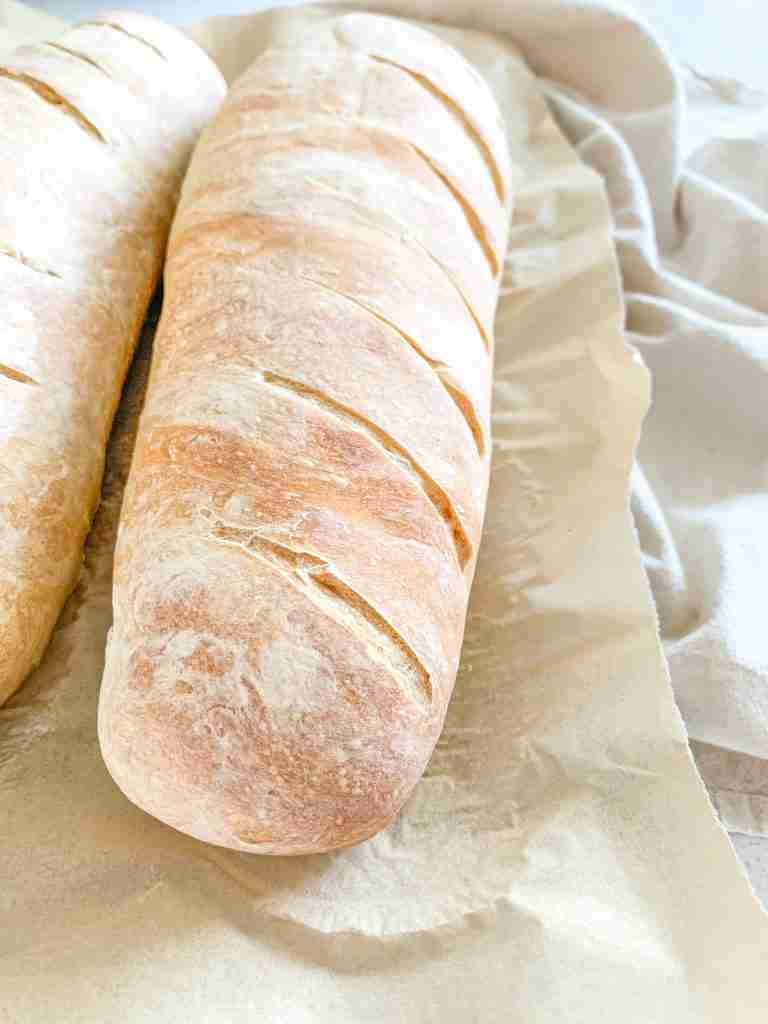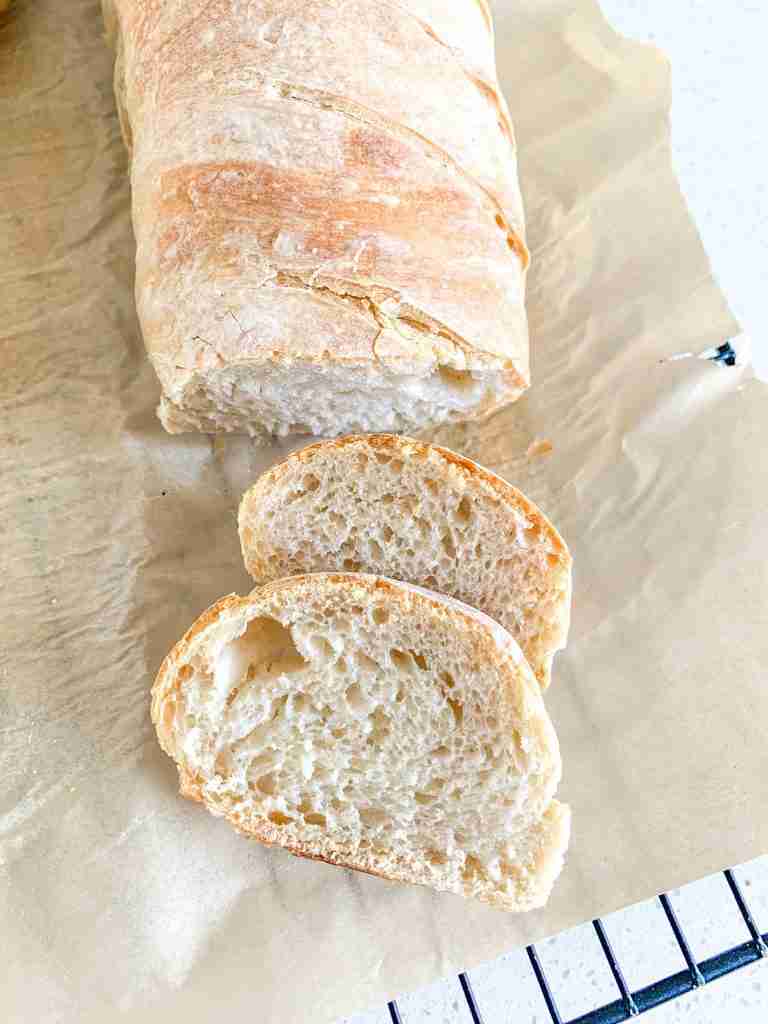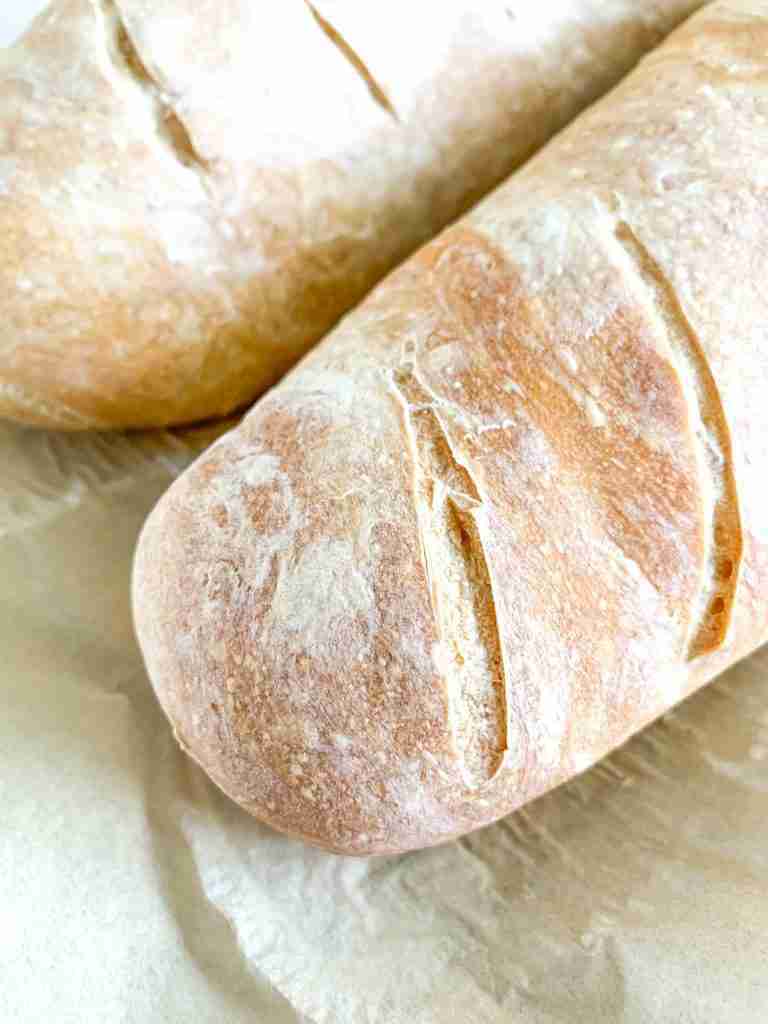Sourdough French Bread
You’ll be surprised how simple it is to make sourdough French bread at home. This recipe will give you a crisp, golden-brown crust and a fluffy, pillowy interior! It’s the perfect bread for sandwiches or serving with butter alongside a meal.
This post may contain affiliate links of items I know and love. Read our disclosure policy for more information. I NEVER use AI (artificial intelligence) to create content for Plum Branch Home. Recipes, blog posts, photos, videos, podcasts, social media content: everything is made from scratch by me, Molly LaFontaine. After developing my recipes, they’re tested 2x by my husband, Tyler, and I before publishing. What you see from Plum Branch Home is real. It’s made for a reason, tested, and loved!

This post may contain affiliate links of items I know and love. Read our disclosure policy for more information.
I developed this recipe one night when I was making my slow cooker French dip sandwiches. I wanted a bread that would hold all the juices and not fall apart.
So I got busy working on the recipe, and my goodness, was I happy with the results! I know you’ll love this recipe just as much as we do!
The base of this French bread recipe is identical to my artisan sourdough bread. I did this because I wanted the interior to be fluffy and soft.
But I also wanted the exterior crust to be crisp and golden brown. That’s exactly what you’re getting with this recipe.

Why You’ll Love My Sourdough French Bread Recipe
- Super easy to follow. This recipe is laid out in a way that even beginners can follow and find the process easy. I believe it shouldn’t be complicated to make bread at home!
- Makes bakery-style bread at home. With this recipe, you can make bakery-style bread at home with your regular oven. The best part is you don’t need fancy tools or a special oven to do it.
- Tastes delicious! The taste of this bread is what you’d imagine when you read the title. It’s that delicious savory sourdough flavor we all know and love.
Is Store-Bought French Bread the Same as Sourdough French Bread?
Not at all. The store-bought or bakery-bought (for the most part) is made with yeast instead of sourdough starter. The yeast rises the dough just like sourdough, but the flavors will be different.
Not to mention French bread on the grocery store shelves is often full of dough conditioners and additives to make the bread soft, whereas this sourdough version is soft due to its fermentation process.

Sourdough French Bread Tips
- Make sure your starter is active! Before you get started with this recipe, you need to feed your starter a 2:1 ratio of flour to water 4–12 hours before you start. Your sourdough starter needs to be very active and bubbly to begin.
- Let the dough bulk ferment for 12 hours. It is important to let your dough bulk ferment for the full 12 hours. It should double in size and have air bubbles in it.
- Place the dough in a warm spot to rise. For both the bulk ferment and the second rise after shaping, your dough needs to be at room temperature in a non-drafty place. If your dough doesn’t look like it’s doing anything halfway through the rises, you need to place it in a slightly warmer area. This can be in a turned-off oven with the light on and oven door open, or you can slightly warm the oven to about 75-80 degrees Fahrenheit, then turn it off and place your dough inside with the door shut. Never leave the oven on, even on the keep warm setting, with fermenting dough inside. Your dough, for both rises, needs to double.
Kitchen Tools You May Need
- large mixing bowl
- bread whisk (optional but super helpful!)
- bread razor or knife
- unbleached parchment paper
- large baking sheet pan
- bench scraper (optional but I LOVE mine!)
Ingredients You Will Need
- fed sourdough starter (should be active & bubbly)
- water
- salt
- all-purpose flour

How to Make Sourdough French Bread
Make the Dough
Feed your starter 4-12 hours before starting this recipe. I recommend feeding it a 2:1 ratio of flour to water. It needs to be active and bubbly to begin this recipe.
In a large mixing bowl, add in sourdough starter, water, and salt, then stir until combined.
Add flour and stir until a shaggy dough forms. Use your hands to bring the dough into a ball. If this isn’t working add 1-2 Tablespoons of extra water to help but don’t do this if not necessary.
Stretch and Fold the Dough
Cover dough with a lid loosely, a damp kitchen towel (that’s been wet then rung out), or plastic wrap. Let dough sit for 30 minutes on the counter at room temperature.
After 30 minutes, begin the first round of stretch and folds. To do this pull a section of the dough upward, folding it into the center, and pressing it down. Repeat this around the dough for 1-2 complete circles.
Cover the dough again and let it sit at room temperature for another 30 minutes. Then, repeat a second round of stretch and folds.
The Bulk Ferment
Cover the dough and let it sit at room temperature on the counter or in a turned-off oven/microwave for 12 hours until it doubles in size.
Once bulk fermentation is complete your dough should have doubled in size. Punch it down to deflate then place the dough on the counter. No flour needed.
Shape the French Bread & Proof
Divide dough into 2 even pieces and roll each piece into a flat rectangle about 1/2 inch thick.
Roll each dough rectangle into a long log shape then pinch the seam of the dough together to seal with your hands. You will also want to tuck the very ends of the logs underneath.
Place the 2 dough logs onto a parchment-lined baking sheet pan and cover with a dry kitchen towel.
Let dough rise for 4 hours or until doubled in size.
Bake and Cool
Preheat the oven to 375 degrees once the logs have doubled in size.
Optional – Use a bread razor or knife to make small, shallow, horizontal slices on the top of each piece of dough. About 6-8 of them.
Bake for 45 minutes.
Place on a cooling rack after baking and brush tops with butter (this will make the crust softer!).
Storage Instructions
Store cooled French bread in an airtight container for about five days at room temperature. After that, you can place it in the fridge for up to two more days.
How to Freeze
Freeze French bread loaves after they’ve been baked and completely cooled down in an airtight freezer-safe container. You can cut the loaves into smaller pieces to make this easier.
They’ll last 3-6 months in the freezer. Thaw in the fridge overnight.

Ways to Serve French Bread
You can serve French bread in a few ways, here are my favorites:
- Sliced with butter and served as a side.
- Sliced and made into sourdough French toast.
- Sliced and used to make sourdough garlic bread.
- Loaves cut down into smaller French bread sandwich rolls for French dips, Philly cheesesteak sloppy joes, and any other meat you desire.

FAQs
Sourdough bread is usually in a small loaf or boule shape, whereas French sourdough bread is shaped into authentic long log-like loaves. They’re also baked to have a crisp, golden-brown crust.
Since you’re using a sourdough starter, it ferments the other ingredients in the recipe during the bulk fermentation. This adds good gut bacteria into your stomach and makes digestion of sourdough bread easier. This fermentation process doesn’t happen when you use commercial yeast.
Find More Simple Sourdough Bread Recipes
- Sourdough Slider Buns
- Sourdough Bread Bowl
- Sourdough Hot Dog Buns
- Sourdough Focaccia Bread
- Sourdough Sandwich Bread
If you made this recipe, give it a 5-star rating on the recipe card below and share a photo on social media! Whether you choose Instagram or Facebook, be sure to tag @plumbranchhome
Recipe

Sourdough French Bread
Ingredients
- 1/2 cup fed sourdough starter (feed starter 4-12 hours before using)
- 1 1/4 cups water
- 2 tsp salt
- 3 1/2 cups all-purpose flour
Instructions
- Feed your starter 4-12 hours before starting this recipe. I recommend feeding it a 2:1 ratio of flour to water. It needs to be active and bubbly to begin this recipe.
- In a large mixing bowl, add in sourdough starter, water, and salt, then stir until combined.
- Add flour and stir until a shaggy dough forms. Use your hands to bring the dough into a ball. If this isn’t working add 1-2 Tablespoons of extra water to help but don’t do this if not necessary.
- Cover dough with a lid loosely, a damp kitchen towel (that’s been wet then rung out), or plastic wrap. Let dough sit for 30 minutes on the counter at room temperature.
- After 30 minutes, begin the first round of stretch and folds. To do this pull a section of the dough upward, folding it into the center, and pressing it down. Repeat this around the dough for 1-2 complete circles.
- Cover the dough again and let it sit at room temperature for another 30 minutes. Then, repeat a second round of stretch and folds.
- Cover the dough and let it sit at room temperature on the counter or in a turned-off oven/microwave for 12 hours until it doubles in size. See notes for more information.
- Once bulk fermentation is complete your dough should have doubled in size. Punch it down to deflate then place the dough on the counter. No flour needed.
- Divide dough into 2 even pieces and roll each piece into a flat rectangle about 1/2 inch thick.
- Roll each dough rectangle into a long log shape then pinch the seam of the dough together to seal with your hands. You will also want to tuck the very ends of the logs underneath.
- Place the 2 dough logs onto a parchment-lined baking sheet pan and cover with a dry kitchen towel.
- Let dough rise for 4 hours or until doubled in size.
- Preheat the oven to 375 degrees once the logs have doubled in size.
- Optional -Use a bread razor or knife to make small, shallow, horizontal slices on the top of each piece of dough. About 6-8 of them.
- Bake for 45 minutes.
- Place on a cooling rack after baking and brush tops with butter (this will make the crust softer!).
Notes
- For both the bulk ferment and the second rise after shaping, your dough needs to be at room temperature in a non-drafty place.
- If your dough doesn’t look like it’s doing anything halfway through the rises, you need to place it in a slightly warmer area.
- This can be in a turned-off oven with the light on and oven door open, or you can slightly warm the oven to about 75-80 degrees Fahrenheit, then turn it off and place your dough inside with the door shut.
- Never leave the oven on, even on the keep warm setting, with fermenting dough inside. Your dough, for both rises, needs to double.

Wonderful French bread!!
Love it’s only 4 ingredients, easy and cheap to make!!
Great for many recipes like French bread pizza, open face sandwich’s, PBH garlic bread with or without PBH pesto recipe, croutons and the list goes on.
Thank you so much!! I’m so happy to hear you’ve found many different ways to enjoy this French bread!
I’ve just started my sourdough, and made two loaves this morning. They turned out delicious and were easy to make. However, I found the outer crust to be really hard, making, using even the sharpest of knives, it difficult to cut through. Any suggestions on why this is or what I might try differently next time.
Thank you!
I’m so happy to hear that!! I suggest baking them 5 minutes less. Your oven may just be a little warmer, this is very common. You can also brush the crust with butter as soon as they come out of the oven. This will soften the crust. If you have more questions don’t hesitate to reach out!